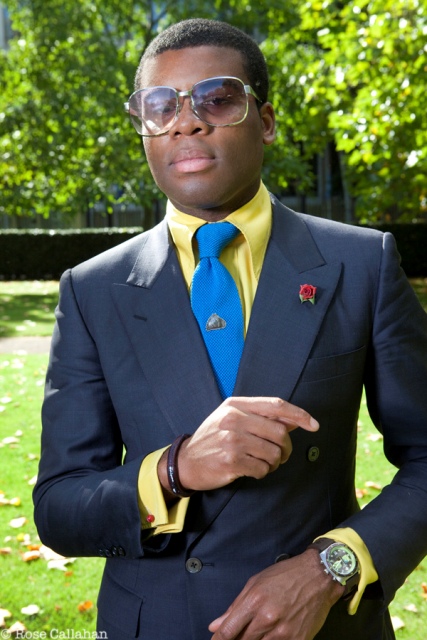 |
| Photograph by the delightful Kira of Scarlet Fever Footwear. L-R: Guy Hills, Winston Chesterfield, Robin Dutt, Dickon Edwards, Ray Frensham, Rose Callahan, Michael "Atters" Attree, Zack MacLeod Pinsent, Natty Adams, Tony Sylvester, your author, Gustav Temple and James Sherwood. In absentia: Nick Foulkes and Amechi Ihenacho |
For every human alive or dead who has considered the maxim "Be yourself" a trite speed ramp on the fast track to a lifetime of misunderstanding and bullying, there are those who have fashioned idiosyncrasy and self-editing into an armour against the world, a means to traverse that of others, or a charismatic gateway to bring different people into theirs. Combined with a particular grasp of tailored masculine presentation and a dash of absinthe (to start with), it is those latter three categories that comprise the myriad subjects of Rose Callahan (photographer; The Dandy Portraits and Rarebit Productions) and Nathaniel Adams (writer; Lives of The Dandies and The Chap)'s photographic text I am Dandy: The Return of the Elegant Gentleman, released this autumn by Berlin's Gestalten. Apparently, there was room for the additional category of "Dashing Dork," because thanks to a recommendation from my dear pal Winston Chesterfield, Rose and Natty readily incorporated your author into the book, with a generous page allowance, several captures highlighting Rose's shutterbug talent and a molecular surgery-level editing of my ramblings that may have taken Natty 72 hours, not including naps
Last night, the UK-based subjects took the stage alongside the creators at Gieves & Hawkes, No. 1 Savile Row, to see in the first of the book's series of international launches, before impelling a minor frenzy of mutual tie straightening and fabric comparisons. I kid. If anything, as a launchpad for the blatantly spreading fame of Callahan and Adams, and an opportunity for me to double fist with a champagne flute in one hand and a tumbler of delightfully caramel-accented The Balvenie scotch in the other, the night's success was a prepotent portent of the action that will follow in Paris and New York over the next 4 weeks. And through that process, two special copies of the book will have been signed by practically every man in it. More will be made (out) of that in time, I know
In-between sampling from the abundant generosity of our hosts, our publisher and our sponsors - The Balvenie; Reyka Vodka, which I'm tempted to use in my next Gimlet cocktail batches for unexpected guests - I took the opportunity to acquaint and re-acquaint myself with a number of folk that I've connected with via The Mode Parade over the years - Davide Taub (G&H's masterful head cutter); rising tailoring star Michael Browne; Shoe Snob Justin Fitzpatrick; tiemaker Shaun Gordon; my drinking buddy, Giant Beard - and those I would have eventually encountered the more I shed my self-professed avoidance of scenes: the other British-based subjects of the book, around half of whom I've already befriended or met - nonpareil party host Guy Hills of Dashing Tweeds; diarist and master of arcane recall Dickon Edwards (clad, as expected in his "Double Dandy" look: one of the late Sebastian Horsley's velvet suits); "gentlethug" punker Tony Sylvester of Turbonegro; The Chap founder Gustav Temple, whom I've even written for (to say nothing of the real world friends who lent their support in person). I particularly enjoyed reuniting with Rose's black watch-clad beau and husband, Kelly Desmond Bray, and meeting Victoriana Boy Wonder, Zack MacLeod Pinsent, with whom I shared the most effete fist bump in history, what with us both wearing chamois dress gloves as we did so
Also in attendance was the quietly sagacious Stewart Gibson, correspondent for Dandyism.net - experiences with which loom large in I am Dandy's profiles - who has already written up his bemused impressions of last night's function. Intriguingly, his choicest descriptor - "representatives of a more considered contemporary dandyism" - was reserved for Winston and me, a generous stand to take on the appearance of a man wearing a bold Holliday & Brown archive print shirt and a Spider-Man pin in his buttonhole
 |
| Your author posing for the main event photographer, Khalil Musa, via Stylesight's coverage of the book party |
My actual thoughts on I am Dandy, having lived with my complimentary copy over the past week, and indeed on dandyism itself are topics for a later day. For now, I have to bask. Not in the prestige of being part of the project. Not even in the faintly ridiculous filmed interview I gave Gestalten five minutes after the bar was finally drained. And certainly not in having the spotlight shone on me and these other interesting individuals for one soggy London evening, knowing all the while who really merited the attention and feeling happiest that way. It's in the fact that this book is allowed to exist in this very world at this very time and people will care for it
And also because in spite of ending the night in a tiny dive bar that was once a brothel (was it bigger on the inside in those days?) and being shot serrated daggers by a jittery man whose girlfriend gave me a friendly peck on the cheek, my head has remained pain free all day. Though that may be the only part I've gotten wrong
And also because in spite of ending the night in a tiny dive bar that was once a brothel (was it bigger on the inside in those days?) and being shot serrated daggers by a jittery man whose girlfriend gave me a friendly peck on the cheek, my head has remained pain free all day. Though that may be the only part I've gotten wrong
















































